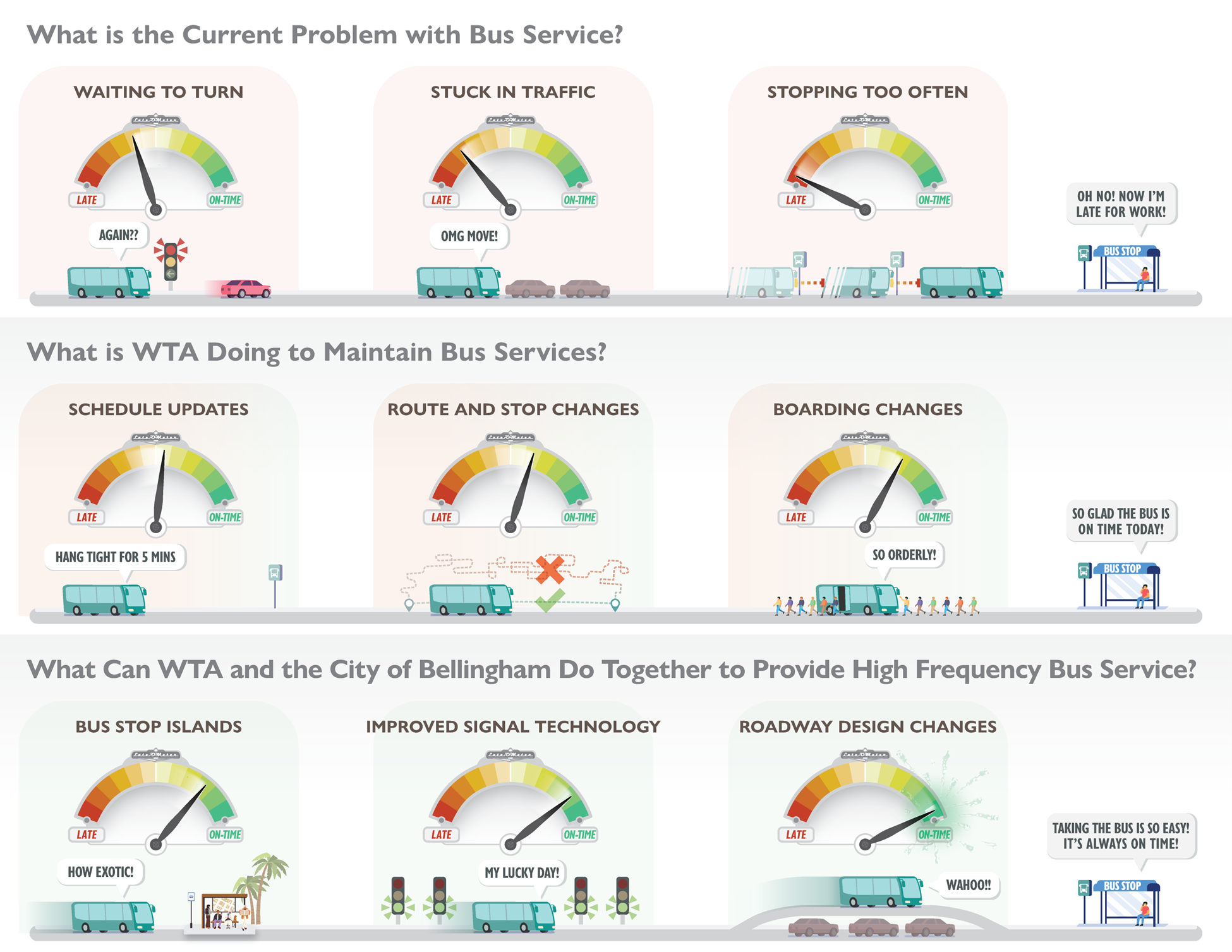Project Overview
WTA and the City of Bellingham are advancing the Rapid Transit Study to identify improvements that would make bus service faster, more reliable, and easier to use along Bellingham’s busiest transit corridors. These corridors, known as "GoLines", include the Blue, Gold, Green, and Plum Lines, connect many of the community’s major destinations, including Downtown, Western Washington University, Cordata, Barkley Village, Sunset Square, and Lakeway.
Since launching the rapid transit study in 2023, WTA has completed the first phase, the Feasibility Study, and has received direction on the Preliminary Locally Preferred Alternative (PLPA). The feasibility work helped identify key challenges such as traffic congestion, long dwell times, and inconsistent bus spacing that reduce the reliability of high-frequency service. It also confirmed that Bellingham’s Go Lines already function as the backbone of the transit network, carrying most of WTA’s riders and serving areas where much of the city’s future growth is planned.
The PLPA was presented to the WTA Board of Directors and the City of Bellingham’s Public Works and Natural Resources Committee in early 2025. Based on their guidance, staff are now preparing a Locally Preferred Alternative (LPA) that focuses on developing an enhanced Go Line network rather than a full Bus Rapid Transit system. The LPA is currently being drafted and will focus on practical and economically viable improvements that strengthen WTA’s existing Go Line network and improve travel time, reliability, and rider comfort.

Service Enhancements Proposed in the LPA
- Bus stop balancing to reduce overall dwell time and improve travel speed
- Schedule adjustments and monitoring to maintain on-time performance
- All-door boarding and off-board fare collection to shorten dwell times at individual stops
- Adjusting route timing and headways to reduce bus bunching
- Adding buses strategically to increase frequency when travel time savings allow
- Bus stop islands to reduce conflicts between buses, bikes, and general traffic and allow in-lane boarding
- Queue jump lanes that let buses bypass congestion at intersections
- Bus-only or priority lanes to improve speed and reliability during congested periods
- Extended turn lanes or pockets to reduce bus delays at intersections
- Roundabout redesigns and access management to accommodate buses and improve circulation
- Stop consolidation and relocation to optimize spacing and pedestrian access
- Enhanced stop amenities including shelters, lighting, seating, and real-time arrival signage
- Bicycle and pedestrian connections to improve first- and last-mile access to Go Lines
- Transit Signal Priority (TSP) upgrades to reduce signal-related delays
- Interconnected traffic signals to coordinate timing and maintain bus progression along corridors
- Updated signal controllers capable of adaptive operation to respond to real-time traffic conditions
- Coordination with the City of Bellingham to align street design standards with transit needs
- Integration of transit priorities into the City’s Comprehensive Plan and Transportation Improvement Program
- Land use updates along Go Line corridors to support higher density and mixed-use development
- Coordination with WWU, schools, and other major destinations to reduce bus delays near campuses and activity centers
- Collaboration with WSDOT to improve intersections on state-managed roadways
Next Steps
WTA and the City of Bellingham are continuing work on the draft Locally Preferred Alternative, which will be shared with the public for feedback in late 2025/early 2026. Public input will help guide final adoption and shape the implementation of projects. The LPA will also inform future planning, funding, and design efforts that continue to strengthen WTA's Go Line network. Most projects identified within the LPA will not have allocated funding sources, however the LPA will be used as a tool to apply for local, state, and federal grant funding opportunities. The LPA will also be accompanied by a Memorandum of Understanding (MOU) which will outline roles and responsibilities between WTA and the City of Bellingham for project implementation.




